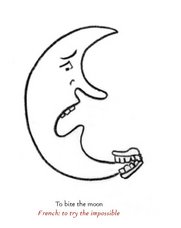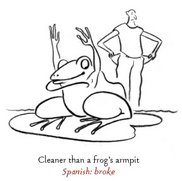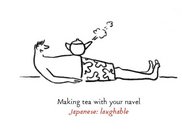Emdashes—Modern Times Between the Lines
The Basics:
About Emdashes | Email us
Ask the Librarians
Best of Emdashes: Hit Parade
A Web Comic: The Wavy Rule
Features & Columns:
Headline Shooter
On the Spot
Looked Into
Sempé Fi: Cover Art
I'm Not Hanging Noodles On Your Ears: Jag Bhalla's Book on Idioms, Illustrated by New Yorker Cartoonist Julia Suits
Filed under: Looked Into Tagged: Bob Mankoff, books, cartoons, etymology, idiom, Jag Bhalla, Julia Suits, language, linguistics, neologisms, Pollux

Illustrations by Julia Suits
(click to enlarge)
Pollux writes:
Enjoying Jag Bhalla’s new book on idioms comes as easily as a river imp’s fart. I’m Not Hanging Noodles On Your Ears, published by the National Geographic Society, is a collection of “intriguing idioms from around the world.”
Hanging Noodles, which also features the work of New Yorker cartoonist Julia Suits’ visualizations of the idioms, collects wonderful and diverse idioms from various languages, including Chinese, Russian, French, Yiddish, and Spanish.
Our brains, as Bhalla explains, enjoy novelty in language and word play, and idioms are perhaps the best example of our collective love for linguistic playfulness. Bhalla calls idioms “frozen metaphors” and the definition is both pithy and apt.
The origins of some idioms have been lost in time. Idioms are living relics that see life everyday despite their hazy origins. They are frozen baby mammoths that we resurrect from the ice on a daily basis.
Idioms are figures of speech that are usually unintelligible to someone who hears them for the first time. If a Russian lets you know, perhaps while you are journeying across the wastes and wonders of Siberia, that he’s not hanging noodles on your ears, he means he is not pulling your leg.
But Bhalla’s Hanging Noodles isn’t a soulless compendium of idioms, but a look at language and its formation. Bhalla prefaces each chapter with a short linguistic study that examines, for example, the capacity for babies and animals to learn languages, the role of facial expressions in language, the role of culture in language, the role of numbers and counting in language, semantic shifts, and what he calls the “woo-woo theory,” in which language may have gained complexity as a result of man’s efforts to woo the opposite sex, with idioms, for example, serving as a sort of linguistic peacock tail.
Bhalla also includes trivia on words and word origins. For example, he mentions a neologism based on the Spanish word tapas (literally “lids”, but referring to the little dishes of appetizers served before the main course), which is crapas -a new coinage used to describe the terrible finger food served at public events. In addition, Bhalla not only discusses the origins of words, but also his own origins, and his own tastes and background regarding language.
Let me mention some of the actual idioms in Bhalla’s book. As the Germans say, here the donkey falls (“that’s the important part”). Some of my personal favorites include “to vomit the sound of weakness” (Japanese, “to whine”), “to show your lamp to the sun” (Hindi, “to waste time”), and “to stick one’s nose in every sour curd cheese” (German, “be nosy”).
Julia Suits’ drawings illustrate the bizarreness of some of these idioms, making Hanging Noodles not only a compendium of idioms, a collection of trivia, an autobiography, and a scholarly look at the history of language, but also a book of cartoons.
Suits’ simple lines are effective in a second translation of these idioms. Idioms such as “to stand like a watered poodle” are translated not only into English, but also into the visual language of cartooning. The result is a series of funny and surreal drawings that demonstrate the great complexity and strangeness of language.
Adding to the bizarreness of these idioms is the fact that Bhalla provides us his frozen metaphors only in their translated, English form. As Bhalla explains, the book is not intended to be a language reference book, but instead his purpose is for you to connect as a reader with the lists of idioms and “make your own sweet, beautiful meaning together.”
Bhalla includes a quote by New Yorker cartoon editor Bob Mankoff that defines humor as the “counterweight to the hegemony of reason,” and Hanging Noodles helps in the good fight against dispassionate logic. “Our minds,” Bhalla writes, “are not as reason-able as we like to think.”
But instead of lumping them in terms of their language of origin, Bhalla groups idioms according to theme or category. Thus, we get chapters such as The Language of Love: Swallowed like a postman’s sock, Colors: Sighing with blue breath, and Time: When dogs were tied with sausages.
This makes the book not only informative but funny. For example, a selection of romance-related idioms includes:
- To live like an old farm rifle (Spanish, Nicaragua): to always be pregnant
- Reheated cabbage (Italian): an attempt to revive an old love affair
- Aunt seducer (German): a young man whose manners are much too good
Idioms enliven and brighten the languages of the Earth. Jag Bhalla’s book, adorned with amusing drawings by Julia Suits, is a welcome addition to the library of anyone who loves words.
Reading I’m Not Hanging Noodles On Your Ears put the butter back in my spinach. I hope it does for you too, and may an onion not grow out of your navel.






